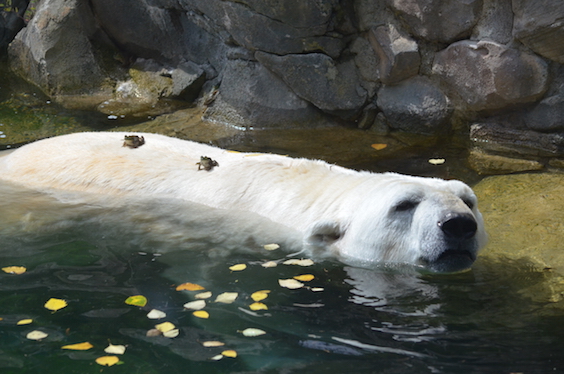The Maryland Zoo in Baltimore is deeply saddened to announce the passing of zoo icon and beloved polar bear, Magnet, age 26. Magnet had recently been diagnosed with kidney disease, but had overall remained in good health. During the past several days, Magnet’s quality of life had declined sharply, and he was humanely euthanized this morning.
“Magnet was truly the single most iconic animal here at the Zoo, to the point of being the model for our logo,” said Don Hutchinson, president and CEO of The Maryland Zoo. “Words cannot describe how our entire staff is feeling, particularly on top of recent events here in Baltimore. From his early years swimming in the Main Valley to diving into the depths by the underwater window at Polar Bear Watch, we think he enjoyed a good life here under the watchful eye of a dedicated staff and amazed zoo visitors.”
Magnet came to The Maryland Zoo at the age of three in 1991 from The Toledo Zoo. “Magnet got his name because he never left his mother’s side when he was young,” said Carey Ricciardone, mammal collection and conservation manager. “He quickly adapted to life here and always seemed to enjoy the company of female polar bears. He was a Zoo favorite since day one, and we will miss him tremendously.”
“At a routine checkup in February Magnet was diagnosed with kidney disease, which is a common ailment in older polar bears,” stated Dr. Ellen Bronson, chief veterinarian for the Zoo. “As a geriatric bear, we focused on keeping his level of care consistent, and providing a specific diet to keep him in good condition and slow progression of the disease. We had been monitoring him for any signs of lethargy or decreased appetite, adjusting medications as necessary, and he was very active during the past few weeks of breeding season which just ended. Unfortunately over the weekend it became apparent that his quality of life was in decline and we knew that the time had come to make the tough decision to euthanize him.”
The Zoo’s polar bears are part of the Association of Zoos & Aquariums (AZA) Species Survival Plan (SSP) which oversees polar bear husbandry and breeding recommendations to ensure genetic diversity in the overall population. Although Magnet was a genetically important polar bear, during his life he only sired one stillborn cub with Alaska in 2006. “We hope that this breeding season was successful, but only time will tell at this point,” said Ricciardone. “No matter the outcome, we are grateful to have had Magnet with us for all these years — he was a very special polar bear.”
“A necropsy will be performed as vital information can continue to be gleaned from him scientifically,” continued Bronson. “He will contribute to research studies to benefit both zoo polar bears and free-ranging bears in the years to come, in order to support the conservation of these amazing and threatened animals.”











Share this article